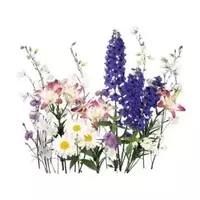Edible flowers

Oddly enough, flowers are not only a means of attention or gratitude, as many people think, but also a food. For this purpose, they even invented a special term - edible flowers or edible flowering plants, which are grown according to environmentally friendly technologies.
Interestingly, the use of edible flowers for culinary purposes began more than 200 centuries ago, when the Aztecs, the peoples of Greece and ancient Rome added them to their dishes. For example, in Greece, food was skillfully decorated not only with the help of petals, but also with whole buds. Such dishes appeared in many areas of the planet independently of each other: edible flowers were popular in Japan, China, Libya, India, and later fell into the cuisine of Italy with France.
Nevertheless, after the waterway to India was opened, edible flowers began to lose their value as a food supplement for upper-class people - spices (in particular, cinnamon, turmeric, saffron, cumin) took their place. Rich people added them to food, but after a while other dishes with edible flowers began to disappear due to the fact that new edible plants began to appear.
Edible flowers became popular again only in the 80s of the twentieth century, and remain in demand to this day, but not as everyday food, but as a delicacy. As you know, nowadays more than 45 types of edible flowers are used for food. It is worth noting that it is quite difficult to find edible flowers on the menu of European restaurants, but in Asia they are ranked among expensive and exclusive dishes.
Edible flowers are used not only as a decoration of meals, but as important ingredients in salads and drinks. In addition, nowadays, edible flowers are of new interest: they are added to jams and jam, frozen in ice cubes, and then added as a decoration of drinks, and are also used in sauces and marinades.
Japan is characterized by the widespread use of chrysanthemums, while European culinary experts favor nasturtium, daisies and violets, most often adding inflorescences or petals to salads or decorating ready-made dishes with edible flowers. Cooks from the Middle East have been using rose flowers for their culinary experiments for hundreds of years, making the fragrant rose water needed to make exotic jams.
edible flowers 0 kCal
Energy value of edible flowers (Ratio of proteins, fats, carbohydrates - ju):
Proteins: 0 g (~ 0 kCal)
Fats: 0 g (~ 0 kCal)
Carbohydrates: 0 g (~ 0 kCal)
 Español
Español Français
Français Português
Português Русский
Русский 简体中文
简体中文 繁體中文
繁體中文 日本語
日本語 한국어
한국어 العربية
العربية Türkçe
Türkçe Қазақ
Қазақ Deutsch
Deutsch Italiano
Italiano Українська
Українська
